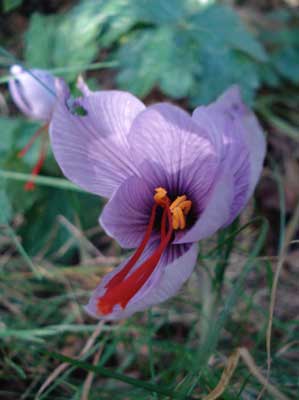
Cartwright Crocus
or, Wild Saffron
"First a howling blizzard woke us,
Then the rain came down to soak us,
And now before the eye can focus--
Crocus."
-Lilja Rogers
(1901-1999)
Crocus cartwrightianus is an autumn-blooming crocus & believed to be the ancestor of the Saffron Crocus, C. sativas.(1901-1999)
It very closely resembles the Saffron Crocus, but with smaller blooms of lilac-blue petals with dark purple feathering, quite varied depending on source, but always beautiful.
Each flower bears the same three enlarged scarlet stigma & three smaller yellow anthers of the Saffron Crocus, but without sufficient flavor of saffron to be a similar source of the spice; so it's only a False Saffron.
It nevertheless has the same saffron odor, & has occasionally been harvested for an inferior saffron spice. It's sometimes likened to "Wild Saffron" since it does not need to be cultivated to persist; C. sativas is sterile & needs to lifted periodically to separate bulbs, & will not spread in the wild on its own, & proves delicate in most of our gardens. The false or wild by contrast is a hardy little bugger that returns year after year.
Its great distinction, besides hardiness, that really sets it apart from C. sativas, is its bunch-flowering habit. Each corm will produce three to ten blooms. It won't be this floriferous its first year in the ground, but by the second year it will put on quite a show, making perfectly clear why it was given the Award of Garden Merit in 1993.
In 2003 we planted eighteen of the bulbs in grass underneath a weeping white birch. The bulbs were cheap because already sprouted when obtained, & we got them in the ground in October thinking this was a bit late for them to do anything immediately, as they should be gotten in the ground by August to bloom in September & October. We figured that they'd do nothing much until autumn 2004.
But to our surprise they bloomed early in November, somewhat tepidly but still very pleasing. The next year, & the next after that, they bloomed in October. They did not "spread" as they're supposed to, probably because the spot under the weeping birch turned out to be too dark for them, & yet they persist as a small drift. We can't lift them, alas, without harming the birch's roots, so if we want them somewhere else, we'll have to buy more bulbs, which eventually I think we will.
Unlike nearly all crocuses, Cartwright Crocus does not close its blossoms at night, suggesting it is pollinated by nocturnal moths. C. tournefortii with an overlapping range in Greece is the only other crocus exception to closing at night.
C. cartwrightianus is hardy to about ten degrees Fahrenheit & do well in zones seven & eight. They need to be in warm soil during their summer dormancy. They should naturalize easily in moderately rich well-draining soil.
There is a white form called 'Albus' which we don't as yet have in our gardens, but which is in fact more commonly available. The white Cartwright crocus looks an awful lot like C. hadriacus ssp parnassicus which is often sold incorrectly as C. cartwrightianus 'Albus.' The error seems almost intentional since it's actually easy to spot the difference, the three scarlet stigma of the Cartwright crocus being three times the length.